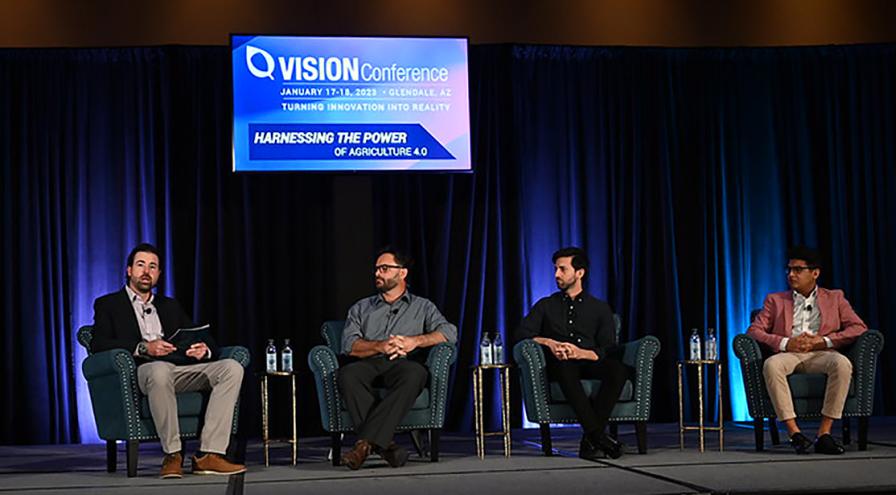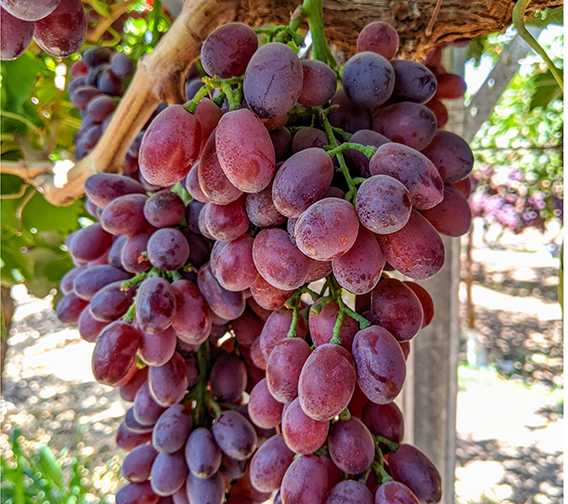What the Future of Automation in Agriculture Might Look Like

At VISION Conference 2023 in Glendale, AZ, (from left): John Appel, Head of Commercial Sales, Biome Makers, moderates a discussion with panelists Gabe Sibley, Founder and CEO, Verdant Robotics; Michael Kohen, Founder and CEO, SparkAI; and Omar Gomez, Washington Lead Executive, Hectre, for the session titled “Making Autonomy Work in Agriculture.”
Photo courtesy of Meister Media Worldwide

Technology has automated the simplest task in agriculture — driving a tractor. But it hasn’t just replicated the ability of a human, it has improved the quality of the work and increased the productivity resulting from the task. So farmers are looking for even more progress. Why isn’t it here yet?
The challenge for autonomous implements or robots is that every other task and decision in agriculture is infinitely more complex than driving a tractor, and growers want simple solutions that make their lives easier and their farms more profitable, says Gabe Sibley, Founder and CEO of Verdant Robotics.
“We took about six months on the road talking with growers who said, ‘Do not give us more data, we have too much data. Tell us what to do with it, or better yet, go do it,’” Sibley says. “You have to perform an action that delivers. You actually have to do the work, not give them data or say this is going to be great one day, just go do a job. So that’s what we are delivering — automated weed control in specialty crops.”
NO MORE GUESSWORK
Concentrating development efforts on creating technology that actually solves a pain point for growers of all sizes makes for products that easily catch on, says Omar Gomez, Washington Lead Executive for Hectre. His company has simplified and vastly improved a key step in apple growers’ profitability — apple sizing. It meets growers’ criteria of simplicity and added value. Spectre allows growers or fieldmen to take a picture of the top layer of apples in a bin, and the artificial intelligence (AI) in the app predicts the sizes and distribution of all apples within the bin.
The technology works immediately without any special equipment. One photo and sizing is vastly more accurate than the old way. This allows growers to make more accurate decisions about their fruit and ultimately increase the value of each harvest.
“We’re able to predict what’s in that entire lot,” Gomez says. “So now you’re making a really good decision on what you have to sell and what you can store longer term. So then when Walmart calls you and says, ‘I want this specific size,’ you can say, ‘I know I can fill that order’ because of the accuracy and the inventory management software. And then ultimately that increases the bottom line for the grower, and the relationship between the wholesaler and the shipper is strong. So that’s what we’re seeing: the great value back for our customer at the moment.”
HUMAN TOUCH
The demand for value in AI applications has led to the presence of companies like SparkAI, which assists developers in navigating the technology that supports the end actions. With a broad base of customers in manufacturing and retail, SparkAI brings that expertise to agriculture, assisting autonomous vehicles with obstacle detection and avoidance as well as computer vision for things like plant health checks and weed detection.
“I think the beautiful thing about human cognition and human abilities is that they’re nimble and they’re adaptable. That’s the thing AI systems have been missing that we deliver in real time,” SparkAI Founder and CEO Michael Kohen says. “Whether a robot is looking at a piece of fruit on a tree or an item on a retail store shelf, the technical challenge is the same.
“But just think about this: This idea that there’s a robot out in the field, it encounters something that needs help, and that decision of how to help needs to come within seconds. That is a non-trivial task both technologically and operationally.”
The secret to developing solutions that work, these technology leaders believe, is working hand in hand with farmers and others along the food supply chain, and that requires an intense partnership. The ultimate value right now is unseen because the partnerships are so new. But quick wins like Spectre from Hectre and Verdant Robotics farming as a service makes farmers want to take the time to bring these technology companies into their operations.
“The most important reason to partner is because right now it’s like the 1950s, and we just invented the transistor,” Sibley says. “The value we’re going to find, when we really digitize and have these machines out there doing this work, is yet to be discovered. And we get to do that collaboratively with the grower and accelerate that discovery by being there, boots on the ground, working shoulder to shoulder with them. They’re pulling us to do that collaboration.”
Grower support is absolutely critical to the success of new technological products. “These are not technologies you kind of lob over the fence and expect somebody’s going to figure it out,” he says.
And at the end of the day, any technology must enhance quality, reduce costs, and increase productivity, according to John Appel, Head of Commercial Sales for Biome Makers.
“I think we will see benefits we haven’t even dreamed about yet,” Appel says.
“We are just getting started on unlocking the potential.”









